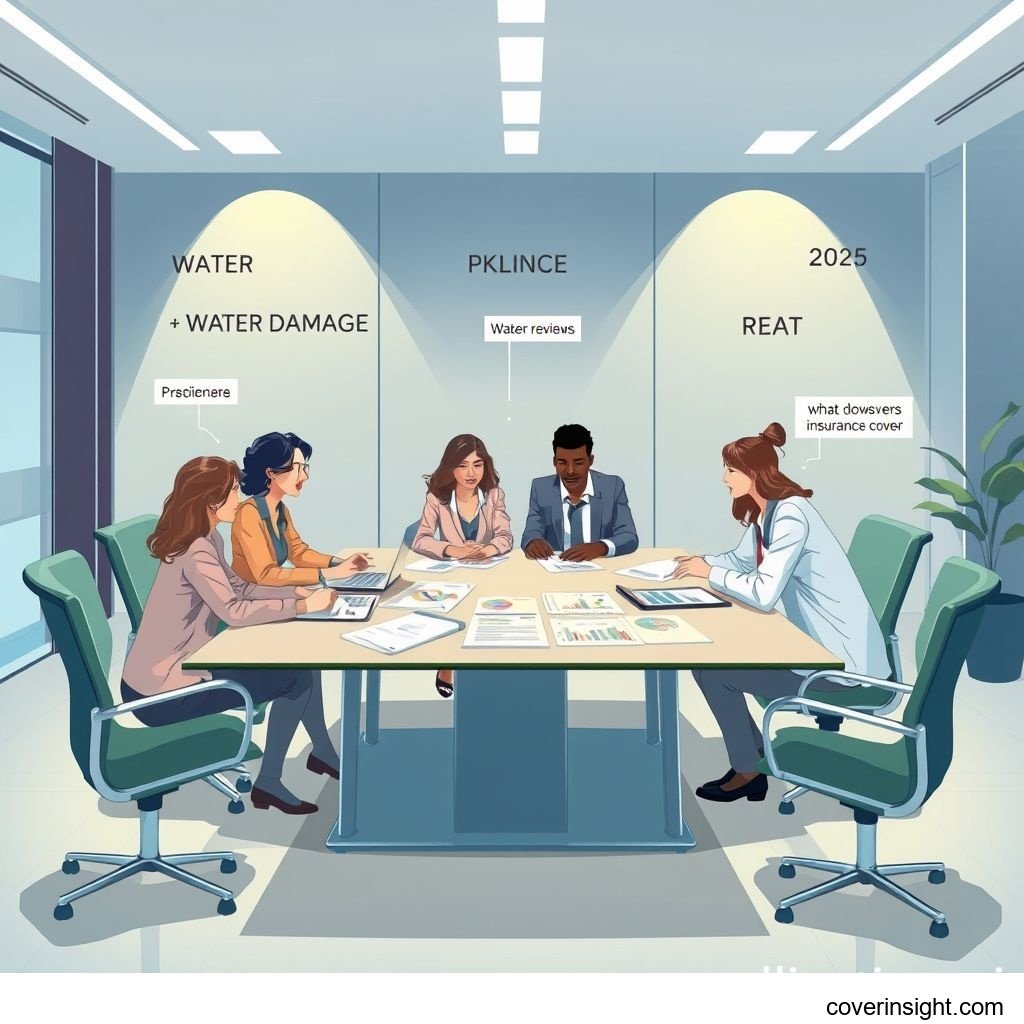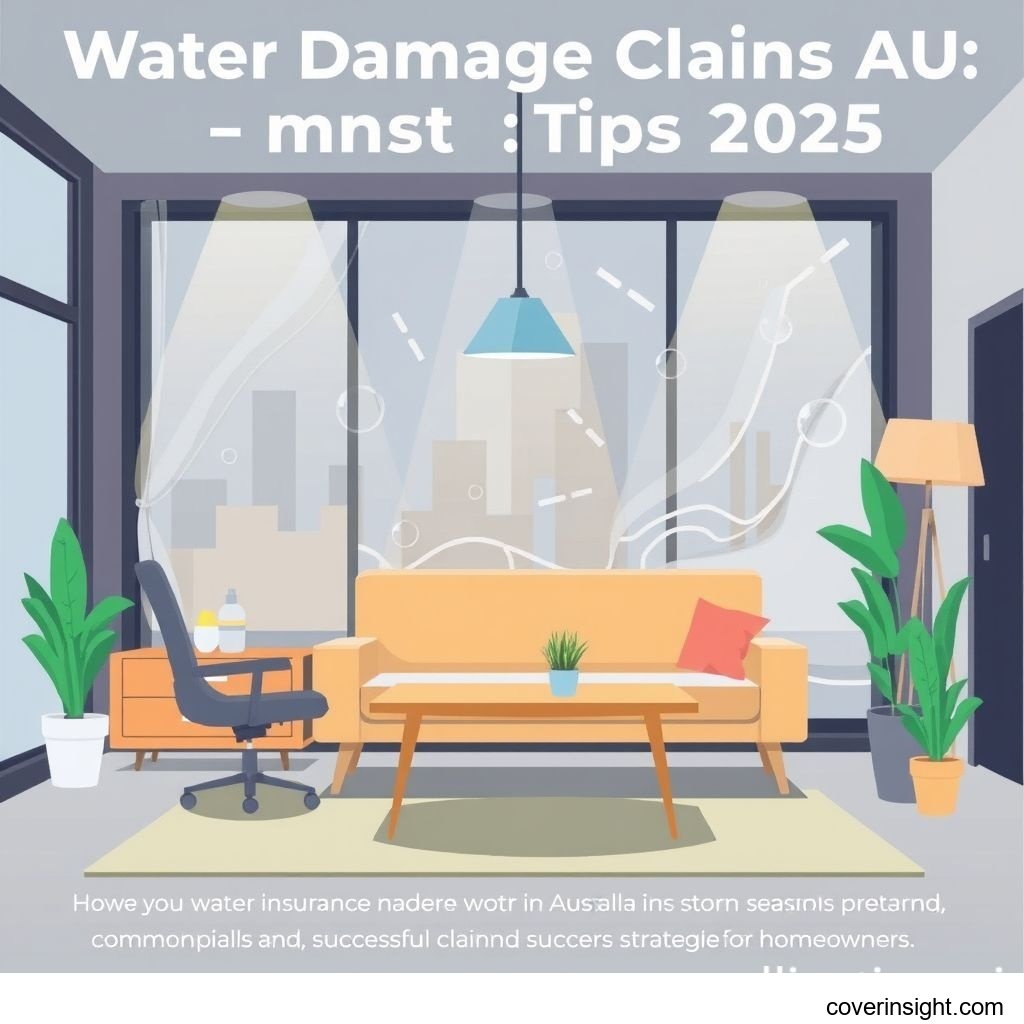AU Home Insurance: Water Damage & Cyclone Prep 2025
Introduction
Homeownership in Australia comes with unique challenges, especially concerning natural perils like cyclones and pervasive issues such as water damage. Understanding what does homeowners insurance cover is not just a financial safeguard; it's a critical component of responsible property management in 2025. This comprehensive guide will navigate the intricacies of home insurance in Australia, highlighting essential coverage aspects, cost factors, and specific considerations for water damage and cyclone preparedness. Protecting your most valuable asset requires foresight and the right insurance policy.
Coverage Details
Navigating the complexities of what does homeowners insurance cover in Australia requires a clear understanding of inclusions and exclusions. Policies are designed to protect against unforeseen events, but their scope can vary significantly between providers. This section clarifies typical policy components.
What’s Included
Australian home insurance policies generally offer protection against a range of specified events, often referred to as 'insured perils'. These typically include:
-
Damage from Fire and Smoke: This covers structural damage and loss of contents due to fire, including bushfires, a significant concern in many Australian regions.
-
Storm and Tempest Damage: Protection against damage caused by high winds, heavy rain, hail, and lightning. This is crucial for cyclone-prone areas.
-
Water Damage (Specific Types): Coverage often extends to sudden and accidental water escape from pipes, washing machines, or burst hot water systems.
-
Theft and Burglary: Financial protection for stolen items and damage to your property resulting from a break-in.
-
Malicious Damage and Vandalism: Covers intentional damage to your home by third parties.
-
Impact Damage: Protection if your home is impacted by vehicles, aircraft, or falling trees.
-
Explosion: Covers damage caused by explosions.
-
Liability Coverage: Provides financial protection if someone is injured on your property and you are found legally liable.
Beyond these core inclusions, many policies offer additional benefits or optional add-ons, such as:
-
Temporary accommodation costs if your home becomes uninhabitable.
-
Cover for landscaping and outdoor structures.
-
Legal expenses.
Common Exclusions
While what does homeowners insurance cover is extensive, it's equally important to understand what it typically does not. Common exclusions are designed to prevent claims for predictable events or issues stemming from poor maintenance. These often include:
-
Gradual Damage: Deterioration from wear and tear, rust, rot, or mould that develops over time due to lack of maintenance.
-
Pest Infestations: Damage caused by termites, rodents, or other pests.
-
Pre-existing Damage: Issues that existed before the policy's inception.
-
Actions of the Sea: Damage caused by coastal erosion, tidal waves, or tsunamis (though some cyclone-related storm surge may be covered if specified).
-
War and Terrorism: Damage resulting from acts of war or terrorism.
-
Illegal Activities: Damage incurred while the property is used for illegal purposes.
-
Unoccupied Property: Limits or exclusions for homes left vacant for extended periods (e.g., 60-90 days), unless specifically arranged.
-
Deliberate Damage: Damage caused intentionally by the policyholder or an authorised resident.
Understanding these exclusions is vital to avoid unwelcome surprises at claim time. Always review the Product Disclosure Statement (PDS) provided by your insurer.
Understanding Water Damage: What Does Homeowners Insurance Cover for Leaks and Floods?
Water damage is a leading cause of home insurance claims in Australia, ranging from minor leaks to catastrophic floods. Delving into what does homeowners insurance cover specifically for water-related incidents is crucial for homeowners.
Types of Water Damage Covered
Generally, home insurance policies differentiate between sudden and accidental water damage and gradual damage.
-
Sudden and Accidental Events: These are typically covered. Examples include:
-
Burst pipes or water heaters.
-
Overflowing bathtubs, sinks, or toilets.
-
Leaking appliances like washing machines or dishwashers.
-
Water ingress due to storm and tempest, such as rain entering through a damaged roof or windows during a severe weather event.
-
-
Damage from External Flooding: This is often a separate add-on. Flood cover protects against damage caused by:
-
The overflowing or breaking of natural watercourses (rivers, creeks).
-
Run-off from heavy rainfall.
-
Inundation by water from the sea, where this is not excluded by "actions of the sea."
-
It's imperative to check if flood cover is included or needs to be added, especially if your property is in a flood-prone area.
-
Preventative Measures & Discounts
While your policy outlines what does homeowners insurance cover, preventative actions can reduce risks and potentially lower premiums.
-
Regular Maintenance: Inspecting pipes, roofing, and gutters regularly can prevent small issues from becoming major claims. Clean gutters prevent water overflow which can damage eaves and foundations.
-
Water Sensors: Installing smart water sensors can detect leaks early, allowing for quick intervention. Some insurers may offer discounts for such installations.
-
Property Upgrades: Investing in flood-resistant landscaping or elevation for properties in flood zones can reduce risk.
-
Timely Repairs: Addressing minor leaks or roofing issues promptly demonstrates due diligence and helps prevent claims for gradual damage which is typically excluded.
-
Know Your Home's Vulnerabilities: Understanding where water might enter your home – be it through a leaky window, a crack in the foundation, or an old pipe – allows you to be proactive.
Cyclone Preparedness and Insurance Claims
Australia's northern regions are particularly susceptible to cyclones, making robust insurance coverage and preparation paramount. Understanding what does homeowners insurance cover in the context of cyclones is vital for residents in these areas.
Pre-Cyclone Checks
Preparation is key to mitigating damage and facilitating smooth claims processes.
-
Review Your Policy: Before cyclone season, thoroughly read your PDS. Confirm your coverage for storm, tempest, and flood (if applicable). Pay attention to specific exclusions related to cyclones, such as storm surge.
-
Secure Your Property:
-
Trim trees and remove loose branches near your home.
-
Clear gutters and downpipes to ensure efficient water runoff.
-
Secure or store loose outdoor items like furniture, tools, and bins.
-
Ensure windows and doors are well-sealed. Consider installing storm shutters if in a high-risk zone.
-
-
Create an Emergency Plan:
-
Develop an evacuation plan with your family.
-
Prepare an emergency kit with essentials: water, non-perishable food, first-aid, important documents (including insurance policy details), and a battery-powered radio.
-
-
Document Your Assets: Take photos or videos of your home's interior and exterior, as well as valuable contents. This evidence is invaluable if you need to make a claim. Store copies securely off-site or in the cloud.
Making a Cyclone Claim
If your home is impacted by a cyclone, a systematic approach to making a claim can significantly ease the process.
-
Safety First: Ensure your family's safety. Do not re-enter damaged property until deemed safe.
-
Contact Your Insurer: Lodge your claim as soon as possible. Most insurers have dedicated catastrophe teams and online portals for rapid claims. Have your policy number ready.
-
Prevent Further Damage: Take reasonable steps to prevent further damage to your property (e.g., tarping a damaged roof), but do not undertake major repairs without insurer approval.
-
Document Damage: Take extensive photos and videos of all damage before any clean-up or repairs begin. Keep damaged items for inspection by an assessor.
-
List Damaged or Lost Items: Create a detailed inventory of all damaged or lost contents. Include descriptions, estimated age, and approximate replacement cost.
-
Keep Records: Maintain records of all communication with your insurer, including names, dates, and times. Keep receipts for any emergency repairs or temporary accommodation.
Special Considerations: What Does Homeowners Insurance Cover for Life Stages?
Home insurance needs evolve with life changes. For instance, what does homeowners insurance cover for individuals approaching retirement differs from the considerations for families with university-bound children.
Tailoring Insurance for Retirement Planning
As you approach retirement, your home often becomes your primary asset and a key part of your retirement planning. Your insurance should reflect this shift.
-
Review Coverage Regularly: Retirement might mean more time at home, potentially altering your contents value or usage. Ensure your coverage aligns with your current lifestyle and asset value.
-
Ageing Infrastructure: Older homes may have ageing pipes or electrical systems. While standard policies detail what does homeowners insurance cover for sudden failures, consider professional inspections and upgrades to prevent common issues that might be excluded as gradual damage.
-
Downsizing or Relocating: If you plan to downsize, ensure your new property is adequately covered from day one. If you intend to rent out your current home, you'll need landlord insurance, not standard home insurance.
-
Valuable Collections: Many retirees invest in art, antiques, or other valuable collections. Standard contents insurance limits might not be enough; consider specific endorsements or separate policies for high-value items. This is crucial for comprehensive retirement planning insurance.
-
Reduced Income: As income changes in retirement, managing premiums becomes more critical. Look for discounts, review your excess options, and ensure your policy remains affordable without compromising essential protection.
Student Insurance Guidance for Dependents
When children move out for university, especially if they are living in shared accommodation or their own apartment, their belongings might no longer be covered under your standard home contents policy.
-
Contents Away From Home: Check if your home contents policy offers 'contents away from home' cover, which might protect items like laptops or electronics while a dependent is at university. This is often limited.
-
Separate Policies for Students: It's often advisable for students to secure their own tenant or contents insurance policy if they live independently. This covers their personal belongings against theft, fire, or water damage in their rented accommodation. This falls under broader student insurance guidance.
-
Liability Concerns: A student's personal liability might not extend from your home policy if they are living elsewhere. A separate policy can also offer personal liability coverage for their rented premises.
-
Valuable Items: If your student takes valuable items, ensure they are specifically listed or covered, either under your policy's 'specified items' clause or their own.
Cost Analysis
The cost of what does homeowners insurance cover in Australia can vary significantly. Understanding the factors that influence your premium and strategies to reduce costs is essential for smart financial planning.
Price Factors
Several variables contribute to your home insurance premium:
-
Location: Properties in areas prone to natural disasters (cyclones, floods, bushfires) or with higher crime rates typically incur higher premiums.
-
Property Characteristics:
-
Construction Type: Homes built with resilient materials (e.g., brick, concrete) may be cheaper to insure than timber or older properties.
-
Age and Condition: Older homes may be more expensive due to ageing infrastructure or higher maintenance risks.
-
Roof Type: Certain roof types are more resistant to storm damage.
-
-
Sum Insured: The higher the combined value of your building and contents, the higher your premium. It's crucial to correctly estimate replacement costs, not market value.
-
Security Features: Installation of alarms, deadlocks, and security systems can reduce premiums.
-
Claims History: A history of previous claims can lead to higher premiums.
-
Chosen Excess: A higher excess (the amount you pay upfront for a claim) usually results in a lower premium, and vice-versa.
-
Inclusions and Exclusions: Adding optional extras like flood cover or accidental damage will increase the premium.
-
Insurer and Policy Type: Different insurers have different pricing models and policy structures. Comparing quotes is essential.
Saving Tips
Reducing your home insurance premium doesn't mean compromising on essential coverage. Here are effective strategies:
-
Shop Around: Obtain multiple quotes from different insurers. Premiums can vary significantly for the same level of what does homeowners insurance cover. Use comparison websites or contact insurers directly.
-
Increase Your Excess: If you can afford a higher out-of-pocket expense in the event of a claim, increasing your excess is a straightforward way to lower your premium.
-
Bundle Policies: Many insurers offer discounts for bundling home and car insurance policies.
-
Improve Security: Install robust security systems, smoke detectors, and quality locks. Inform your insurer about these enhancements.
-
Maintain Your Property: Regularly maintaining your home (e.g., clearing gutters, fixing leaks) reduces the likelihood of claims, which can positively impact future premiums.
-
Pay Annually: Paying your premium annually instead of monthly can sometimes result in a small discount.
-
Review Your Sum Insured: Annually review your building and contents sum insured. Ensure you're not over-insuring, but also avoid under-insuring.
-
Consider Discounts: Ask insurers about loyalty discounts, online application discounts, or pensioner discounts.
FAQs
Here are answers to common questions about what does homeowners insurance cover in Australia.
-
How much does what does homeowners insurance cover cost?
The cost varies widely, typically ranging from AUD 1,000 to AUD 3,000+ annually, depending on factors like location, property value, claims history, and chosen coverage. Properties in high-risk areas for cyclones, floods, or bushfires may have significantly higher premiums. It's crucial to obtain personalised quotes.
-
What affects premiums?
Premiums are primarily affected by:
-
Location: Risk of natural disasters (cyclones, floods, bushfires) or crime rates.
-
Property Details: Age, construction materials, roof type, and security features.
-
Sum Insured: The replacement value of your building and contents.
-
Claims History: Previous claims can increase future premiums.
-
Chosen Excess: A higher excess generally means a lower premium.
-
Optional Extras: Additional coverage like flood insurance or accidental damage.
-
-
Is it mandatory?
No, home insurance is not legally mandatory in Australia. However, if you have a mortgage, your lender will almost certainly require you to have building insurance as a condition of the loan to protect their financial interest in the property. Contents insurance is always optional but highly recommended.
-
How to choose?
Choosing the right policy involves:
-
Assessing Your Needs: Determine the correct sum insured for your building and contents. Consider your specific risks (e.g., cyclone, flood).
-
Comparing Policies: Don't just look at price. Compare what does homeowners insurance cover specifically in the Product Disclosure Statement (PDS) for each policy, paying close attention to exclusions and limits.
-
Checking Reputation: Research the insurer's claims handling reputation and customer service.
-
Considering Add-ons: Decide if you need extra cover like flood insurance, accidental damage, or specific coverage for high-value items.
-
Reviewing Excess Options: Choose an excess you are comfortable paying in the event of a claim.
-
-
Consequences of no coverage?
Without home insurance, you bear the full financial burden of any damage to your property or contents. This could include:
-
Complete loss of your home and possessions due to fire, storm, or flood.
-
Expensive repair costs for burst pipes or structural damage.
-
Liability for injuries to visitors on your property.
-
Significant financial hardship, potentially leading to bankruptcy. For mortgage holders, it could also breach loan agreements.
-
Securing adequate home insurance is a cornerstone of financial security for Australian homeowners. By understanding what does homeowners insurance cover, actively preparing for potential threats like water damage and cyclones, and regularly reviewing your policy, you can ensure your home remains a safe and protected asset for years to come. For further insights into financial protection and long-term planning, explore resources on Insurance Resources Global. For Australia-specific insights, visit AU Insurance Home. Additionally, for comprehensive regulatory information on Australia's insurance industry, refer to the Australian Prudential Regulation Authority, and for industry standards and consumer information, the Insurance Council of Australia is an invaluable resource.








Comments